May 30, 2025 | 02:10 GMT +7
May 30, 2025 | 02:10 GMT +7
Hotline: 0913.378.918
May 30, 2025 | 02:10 GMT +7
Hotline: 0913.378.918
14 years ago, the residents of Moc Chau district (Son La province) saw an Japanese elderly man cycling from the town to Tropical Flower Company to take care of a strange plant - the strawberry plant. It was Otsuka Yoshio, 80, a genuine Japanese strawberry cultivator with 40 years of experience.

Guests come to experience strawberry picking at Hana's farm. Photo: Nga Huyen.
When he reached old age and amassed sufficient funds, he planned to introduce the strawberry plant to Southeast Asian nations in an effort to boost their economies. In 2009, he traveled to Thailand and Vietnam, and he decided to halt in Moc Chau, where he found it to be appropriate, to bring hundreds of Tochiotome strawberry seedlings for pilot sowing at Tropical Flower Company.
These Japanese plants are deemed suitable for the climate of Moc Chau and have become more verdant. The first kilogram of produce harvested was transported to Hanoi for evaluation by a Japanese restaurant.
Mr. Otsuka Yoshio returned to Japan in search of a "successor" due to his advanced age. In 2010, he invited Hana, a designer with an adventurous temperament and a passion for agriculture, to Vietnam.
Mr. Hana planted strawberries outdoors for the first time in the commune of Tan Lap (district of Moc Chau) the first year, but they all perished due to either a humid climate or a technical error. Then, he took the seedlings back to Moc Chau town to sow them and discovered that they were quite suitable. Hana rented land in Bua village, Dong Sang commune (Moc Chau district), established Viet Nhat Fruit and Vegetable Company and received an investment certificate in 2012 while considering the long term.
In 2015-2016, after numerous trials, Japanese strawberries sold in Hanoi also started to be branded, and consumers began to purchase them.
In late September 2023, I traveled to Moc Chau. Everyone was busy preparing seedlings and growing media during the busiest time of the strawberry growing season. Ms. Nguyen Thi Huyen, superintendent of the property, stated that she has followed Hana since its inception.

Hana is introducing guests to her strawberry garden. Photo: Nga Huyen.
Strawberry cultivation resembles that of pennywort. In November, the mother tree is cultivated, and in March of the following year, it is planted in order to propagate progeny. From March until September, seedlings are cultivated. A crop that is planted in September and harvested in November, spanning approximately 140 to 150 days. All stages of strawberry cultivation, including breeding, sowing, flowering, and fruiting, require meticulous attention and care. At first, the farm grew strawberries in the ground, but because it was difficult to manage and susceptible to disease, it shifted to semi-hydroponic cultivating in coconut fiber substrate.
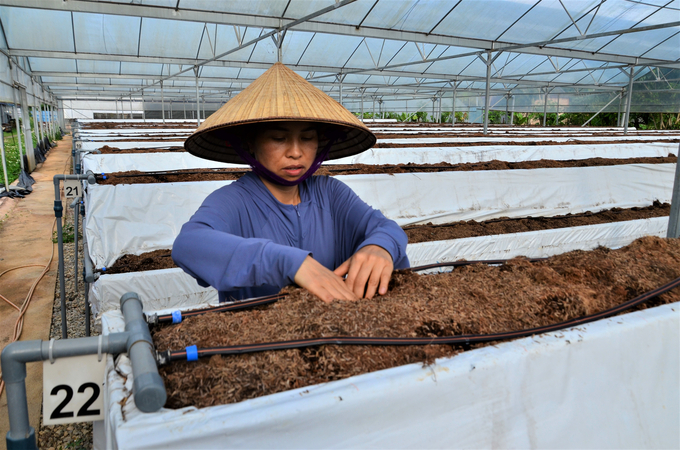
Ms. Nguyen Thi Huyen is checking the humidity of the substrate trays. Photo: Duong Dinh Tuong.
After each strawberry harvest, the soil must be disinfected by mixing rice bran into the soil and then saturating it with water to encourage the growth of hazardous microbes. Wait until there are numerous, then cover the surface with nylon. In the months of May and June, the temperature within the nylon membrane that covers the ground reaches 50 to 60 degrees Celsius, suffocating disease-causing microorganisms. Additionally, the method for cultivating strawberries on a substrate requires that the substrate be treated in the same manner after each harvest.
After sterilization, in July, remove the nylon, dry the soil until it is spotless and dry, and then combine it with coconut fiber. To maintain the beneficial bacteria, keep the soil moist every day, even though there are no plants yet, and wait until September to disperse the seeds.
The Japanese strawberry farm's 9000m2 net house is divided into four producing areas, including one reproductive area where pesticides are still used, but in accordance with Japanese safety standards. Despite the continued use of chemical fertilizers, microorganisms are grown and rice residues are incorporated into the substrate. During the crop season, spiders are released into the net house to consume harmful insects, thereby reducing the need for pesticides, and bees are released to pollinate the blossoms.
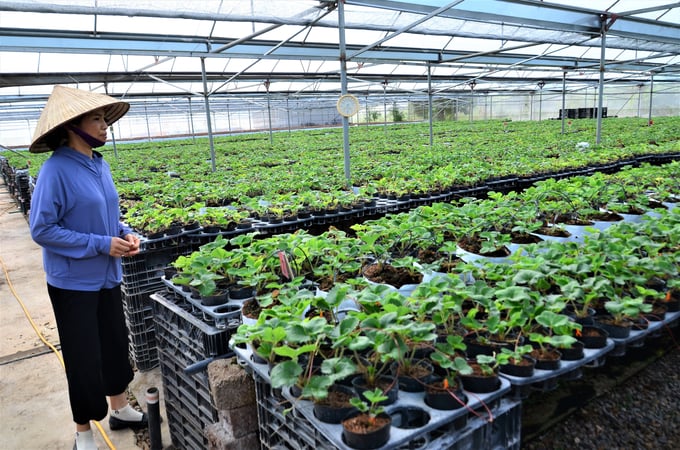
Ms. Nguyen Thi Huyen next to strawberry seedlings. Photo: Duong Dinh Tuong.
This strawberry variety was investigated in Thailand by Mr. Otsuka Yoshio's Japanese acquaintance. This region shares the same latitude as the Moc Chau district, so cultivating it here is ideal. The strawberries of Hana satisfy Vietnamese palates. The fruit is tastier than those cultivated in Japan because it is not too soft, has sufficient sourness, sweetness, and fragrance, and is not overly sweet. The majority of Vietnamese want to obtain money rapidly, whereas Japanese do not take their time and do not haste.
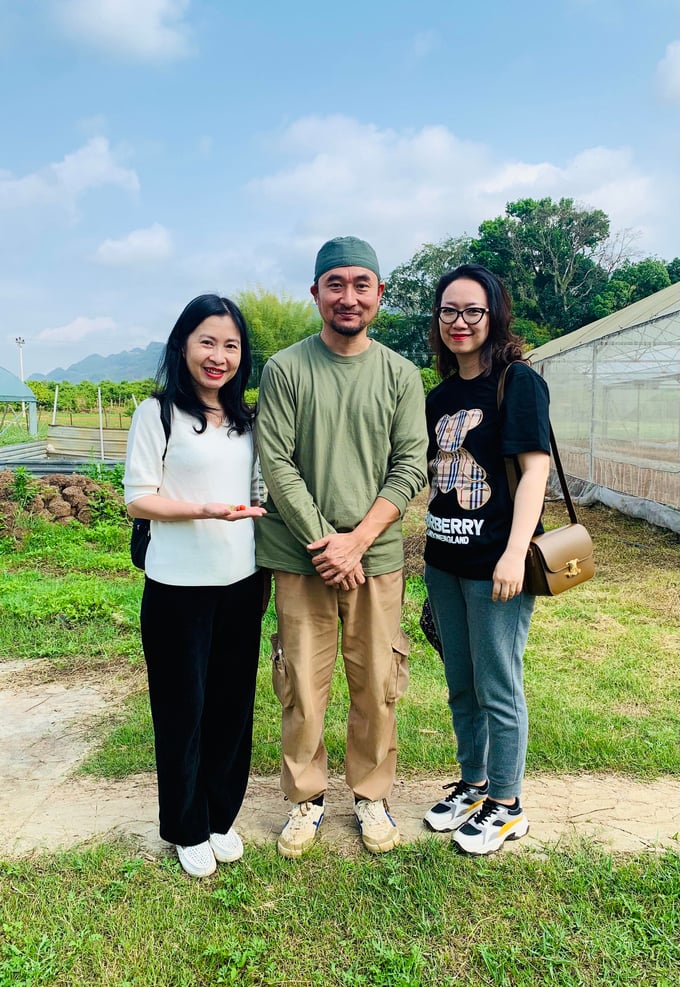
Hana took photos with visitors to the garden. Photo: Nga Huyen.
Hana planted only 1,000 trees as a test the first year. In the second year, 2,000 trees were planted. Then, in the succeeding years, the number of trees planted increased slightly each year, and there are now more than 25,000 trees producing crops that are consumed primarily on the Hanoi market. Hana does not offer excursions because he wishes to focus on production, despite the fact that the garden is very attractive and many people wish to visit.
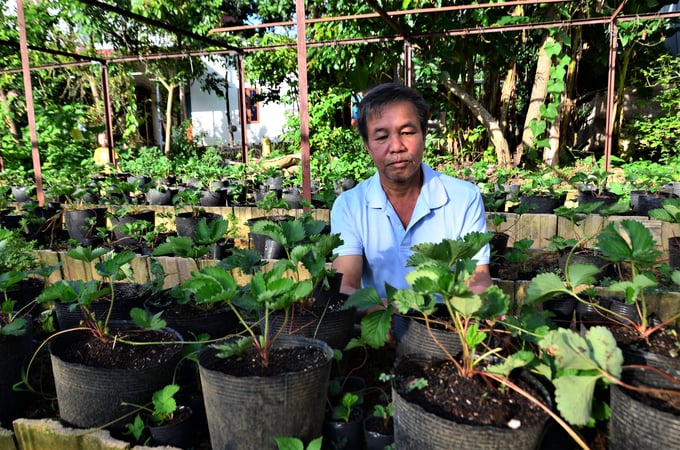
Strawberry garden of Mr. Hoang Van An - Head of Buu village. Photo: Duong Dinh Tuong.
Hana is the most diligent individual in the community, working from dawn to dusk in the garden, and he is unfazed by failure. Although it is a business, Hana and Ms. Huyen do the majority of the labor and employ a few others. In 2016, there was a flood, water surged through the gate, the entire village came out to help, clothed themselves in rocks and dirt, and blocked Hana's gate. The furniture was adrift, but fortunately, the strawberries were unaffected.
Translated by Linh Linh

(VAN) Ms. Nguyen Thi Dung, Deputy Director of Ngoc Hoang Cooperative, shared about the journey of bringing dragon fruit to Europe, achieving annual revenues in the billions of VND.
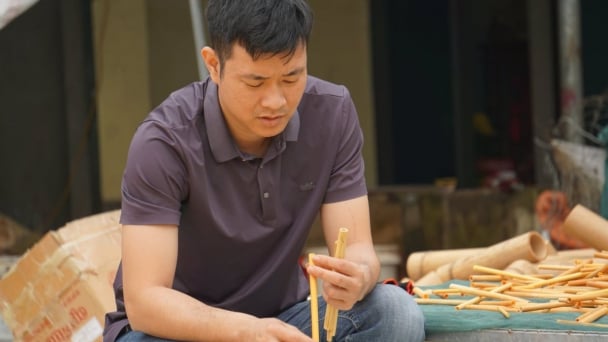
(VAN) Bamboo products from Thang Tho Bamboo Cooperative have reached many countries around the world, while also creating jobs for local workers.
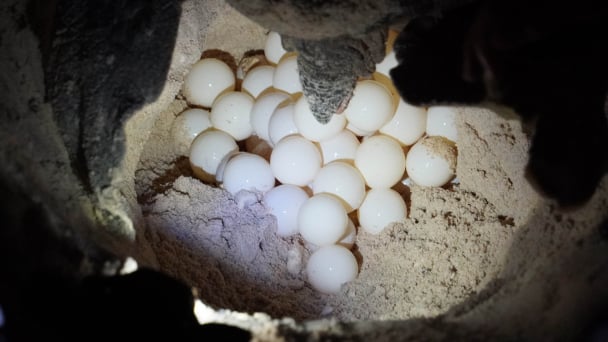
(VAN) The Management Board of Con Dao National Park reported that a green sea turtle, tagged in the Philippines, has traveled thousands of kilometers to lay 84 eggs on Bay Canh Islet.
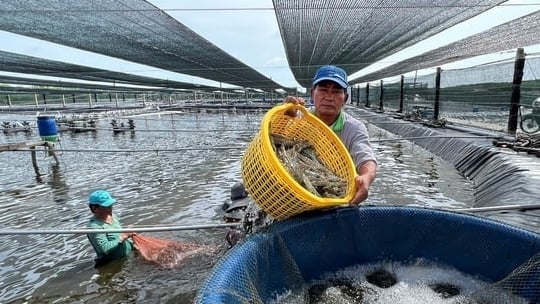
(VAN) Green technology is paving a new path for sustainable aquaculture in the Mekong Delta in particular and across the country in general, helping reduce emissions and adapt to climate change.
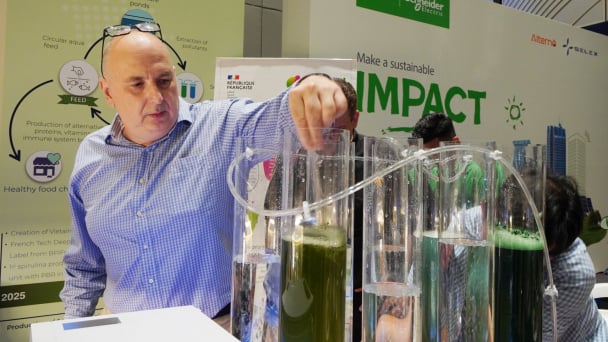
(VAN) On May 27, La French Tech Vietnam (the French startup and innovation community in Vietnam) held the French Tech Summit Vietnam 2025.
/2025/05/27/4731-2-223159_980.jpg)
(VAN) No votive paper, no styrofoam, no plastic bags, no plastic bottles, and no single-use plastic trays are the key rules tourists should keep in mind when visiting Con Dao.
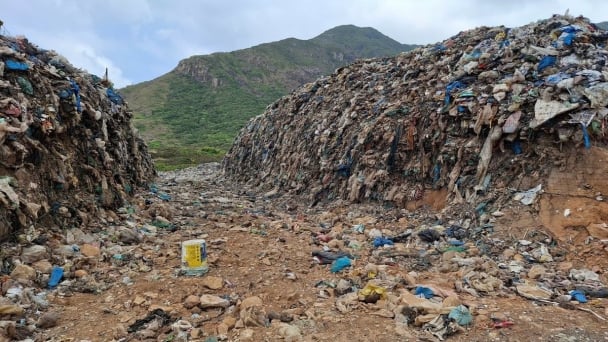
(VAN) In the fight against plastic pollution, Vietnam has been demonstrating a proactive, pioneering, and active role in addressing the greatest environmental challenge today.